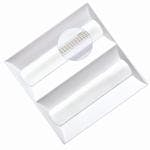LFI report, part 1: Linear LED lighting, OLED and planar lighting (MAGAZINE)
+++++
This article was published in the July/August 2011 issue of LEDs Magazine.
View the Table of Contents and download the PDF file of the complete July/August 2011 issue.
+++++
LFI report, part 2: Retrofit lamps, modular SSL
LFI report, part 3: LED technology, outdoor lighting
+++++
LEDs again stole the show at the annual Lightfair International (LFI) tradeshow. While you could find plenty of conventional lighting on the exhibit floor, it was solid-state lighting (SSL) products that were prominent in most booths, ranging from A-lamp retrofits to decorative and architectural lighting. Purpose-built LED-based linear lighting that might replace fluorescent fixtures was arguably the biggest story. There was little new on the OLED lighting front at LFI, but other planar technologies are coming to market. There were both new players and new looks in outdoor SSL. And adaptive-control technology for sensing and controlling light levels is headed into the mainstream – despite the lack of broadly-accepted industry standards.
LFI continues to surge in popularity and surely LED lighting is partially responsible. Despite some concern in the industry about moving LFI to Philadelphia due to construction issues at the New York venue, registered attendance hit 23,709 – up slightly from last year’s Las Vegas show.
Again this year SSL dominated the LFI Innovation Awards. The Most Innovative Product of the Year award went to the Revel OLED luminaire from Acuity Brands. The Design Excellence Award went to Tech-Generation Brands for a low-voltage LED-based wall washer. Philips Lumileds took the Technical Innovation Award for its Luxeon A LED that the company is hot-testing at typical operating temperatures of 85°C. LED-based products also dominated the product-category awards, with winners including Cooper Lighting, Visa Lighting, and Lumenpulse.
Ironically, LEDs were an afterthought in the keynote presentations this year. But the conference sessions included plenty of LED-centric content.
We’ve already provided quite a lot of LFI product coverage on our website. See the three summary articles for links to the coverage (www.ledsmagazine.com/news/8/5/19, www.ledsmagazine.com/news/8/5/21, and www.ledsmagazine.com/news/8/5/24).
In the following pages, we’ll present what we saw as the most-compelling product announcements and demonstrations in OLED and planar lighting, linear LED lighting, LED retrofit lamps, modular SSL products, LED technology, outdoor lighting, and other areas.
++++
Section 1: Linear LED lighting
++++
At LFI a year ago, LED-based lamps designed to replace T8 linear fluorescent tubes were in the headlines as many companies sought to deliver an SSL retrofit for what is the largest installed base of office and industrial lighting. But as we reported after the show, LED tubes haven’t delivered equitable performance.
This year the focus was more on purpose-designed LED-based fixtures that can serve in place of fluorescent troffers. That’s not to say there weren’t LED tubes on display. In fact, Cree showed a T8 tube reference design that product marketing manager Paul Scheidt said “addresses all of the shortcomings that the US Department of Energy (DOE) has documented about LED T8s.” Still, the bigger fluorescent-replacement news in the Cree booth was the CR fixture that the company launched prior to the show.
The product also integrates support for Acuity’s lighting-control technology that relies on wired links between fixtures using Cat-5 (computer-network) cables. Moreover the products implement what the company calls lumen management where the LED driver produces less output early in the fixture life and increases the output over time to combat lumen depreciation.
Lithonia also demonstrated square surface fixtures called TLED, and square recessed ACLED coffer fixtures, both of which use an array of LEDs and feature integrated controls.
Just after LFI, Sylvania’s sister business unit Osram Opto Semiconductors announced the Duris E3 LED designed with a wide beam angle to produce uniform light in linear fixtures.
The module design is based on a dense array of relatively low-power (0.25W) LEDs, and the design only drives the LEDs at half the rated power. The scheme optimizes efficacy, according to Cooper, and will yield products that last 50,000 hours. The company asserts that its linear products will match or exceed fluorescent systems in optical performance with a 15-20% reduction in power density.
++++
Section 2: OLED and planar lighting
++++
Acuity Brands took the top LFI Innovation Award with its Revel OLED luminaire, and actually announced two OLED products at LFI. The ceiling-mounted Revel (pictured) is more decorative in nature although the individual OLED modules can be positioned to direct light where it is needed. The Kindred is a stylish ambient light designed to be suspended from the ceiling. The Kindred integrates more OLED panels and produces more than 3000 lm in aggregate. Acuity termed the LFI announcement a commercial launch, but the products will not be available until the first quarter of 2012.
As shown in the picture, the panels are relatively small, but Oree believes they can be combined to construct much larger fixtures. Each small panel includes built-in LED emitters. Future plans to have a demonstration platform available for sale by the end of the summer, allowing product designers to experiment with the technology and start luminaire designs. Separately, Future announced an intelligent lighting platform based on a partnership with Synapse Wireless.










